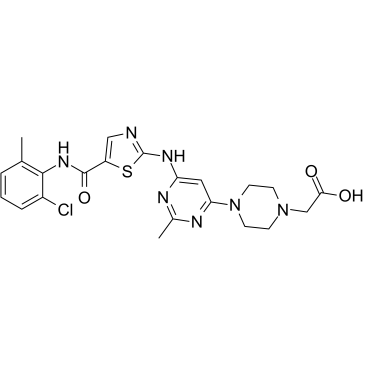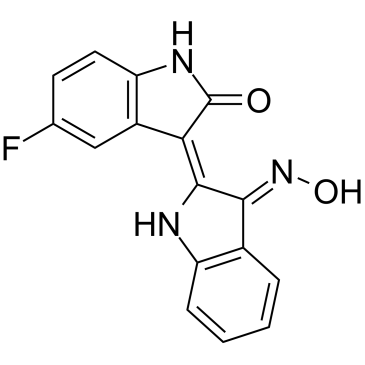 To enhance service speed and avoid tariff delays, we've opened a US warehouse. All US orders ship directly from our US facility.
To enhance service speed and avoid tariff delays, we've opened a US warehouse. All US orders ship directly from our US facility.
| Cat. No. | Product Name | Field of Application | Chemical Structure |
|---|---|---|---|
| DC40530 | (S)-O-Desmethyl Venlafaxine N-Oxide |
(S)-O-Desmethyl Venlafaxine N-Oxide is a N-oxyde of (S)-O-Desmethyl Venlafaxine. O-Desmethyl Venlafaxine is an active metabolite of Venlafaxine. Venlafaxine is an antidepressant of the serotonin-norepinephrine reuptake inhibitor (SNRI) class.
More description
|

|
| DC41187 | (R)-(-)-O-Desmethyl Venlafaxine D6 |
(R)-(-)-O-Desmethyl Venlafaxine D6 is the deuterium labeled (R)-(-)-O-Desmethyl Venlafaxine. O-Desmethyl Venlafaxine is an active metabolite of Venlafaxine. Venlafaxine is an antidepressant of the serotonin-norepinephrine reuptake inhibitor (SNRI) class.
More description
|

|
| DC41188 | (S)-(+)-O-Desmethyl Venlafaxine D6 |
(S)-(+)-O-Desmethyl Venlafaxine D6 is the deuterium labeled (S)-(+)-O-Desmethyl Venlafaxine. O-Desmethyl Venlafaxine is an active metabolite of Venlafaxine. Venlafaxine is an antidepressant of the serotonin-norepinephrine reuptake inhibitor (SNRI) class.
More description
|

|
| DC42345 | Dasatinib metabolite M6 Featured |
Dasatinib metabolite M6 (Dasatinib carboxylic acid) is an oxidative metabolite of Dasatinib. Dasatinib is a potent and orally active dual Bcr-Abl and Src family tyrosine kinase.
More description
|

|
| DC41590 | Sarafotoxin S6a TFA |
Sarafotoxin S6a TFA , a sarafotoxin analogue, is a endothelin receptor agonist and has an ETA/ETB selectivity profile similar to that of Endothelin-3. Sarafotoxin S6a TFA elicits the pig coronary artery with an EC50 value of 7.5 nM.
More description
|

|
| DC40882 | 17-DMAP-GA |
17-DMAP-GA, a Geldanamycin analogue, is an inhibitor of HSP90. 17-DMAP-GA causes cell cycle abnormalities.
More description
|

|
| DC44098 | exo-IWR-1 |
exo-IWR-1, an inactive stereoisomer of Endo-IWR-1, is a negative control of IWR-1. IWR-1 is a tankyrase inhibitor which inhibits Wnt/β-catenin signaling pathway.
More description
|

|
| DC41589 | Sarafotoxin S6a |
Sarafotoxin S6a, a sarafotoxin analogue, is a endothelin receptor agonist and has an ETA/ETB selectivity profile similar to that of Endothelin-3. Sarafotoxin S6a elicits the pig coronary artery with an EC50 value of 7.5 nM.
More description
|

|
| DC40283 | Homobaldrinal |
Homobaldrinal is a decomposition product of Valepotriate. Homobaldrinal exhibits genotoxic activity in the Salmonella/microsome test.
More description
|

|
| DC71393 | Cortisol sulfate sodium |
Cortisol sulfate sodium (Cortisol 21-sulfate) is a metabolite of Cortisol. Cortisol sulfate sodium is a specific ligand for intracellular transcortin.
More description
|

|
| DC42559 | Piperidine-GNE-049-N-Boc |
Piperidine-GNE-049-N-Boc is a ligand for target protein for PROTAC of dCBP-1. dCBP-1 is a potent and selective heterobifunctional degrader of p300/CBP.
More description
|

|
| DC42556 | Thalidomide-NH-PEG4-COOH |
Thalidomide-NH-PEG4-COOH is an E3 ligase ligand-linker conjugate which can be used for synthesizing dCBP-1. dCBP-1 is a potent and selective heterobifunctional degrader of p300/CBP.
More description
|

|
| DC40776 | Necroptosis-IN-1 |
Necroptosis-IN-1, an analog of Necrostatin-1, is a potent necroptosi inhibitor. Necroptosis-IN-1 is a RIPK inhibitor.
More description
|

|
| DC41193 | Proguanil hydrochloride |
Proguanil hydrochloride, an antimalarial prodrug, is metabolized to the active metabolite Cycloguanil. Proguanil hydrochloride is a dihydrofolate reductase (DHFR) inhibitor.
More description
|

|
| DC42354 | Cortisol sulfate |
Cortisol sulfate (Cortisol 21-sulfate) is a metabolite of Cortisol. Cortisol sulfate is a specific ligand for intracellular transcortin.
More description
|

|
| DC49422 | Sulfadiazine-13C6 |
Sulfadiazine-13C6 is a labeled Sulfadiazine. Sulfadiazine is a sulfonamide antibiotic with antimalarial activity.
More description
|

|
| DC44560 | (E/Z)-AG490 |
(E/Z)-AG490 ((E/Z)-Tyrphostin AG490) is a racemic compound of (E)-AG490 and (Z)-AG490 isomers. (E)-AG490 is a tyrosine kinase inhibitor that inhibits EGFR, Stat-3 and JAK2/3.
More description
|

|
| DC46258 | VHL Ligand-Linker Conjugates 17 |
VHL Ligand-Linker Conjugates 17 incorporates a VHL ligand for the E3 ubiquitin ligase, and a PROTAC linker. VHL Ligand-Linker Conjugates 17 can be used in the synthesis of a series of PROTACs, such as ARD-266. ARD-266 is a highly potent androgen receptor (AR) PROTAC degrader.
More description
|

|
| DC42411 | Vat Blue 2 |
Vat Blue 2, a indigo derivative, is a dark blue 5,5'-dibromo-4,4'-dichloroindigo dye.
More description
|

|
| DC41002 | 5-HT1A modulator 2 hydrochloride |
5-HT1A modulator 2 hydrochloride, a derivative of 8-OH-DPAT, is a modulator of 5-HT1A with a Ki of 53 nM for 5-HT1A binding.
More description
|

|
| DC41289 | N-Desmethyl imatinib mesylate |
N-Desmethyl imatinib mesylate (Norimatinib mesylate) is a metabolite of Imatinib. Imatinib is a multi-target inhibitor of v-Abl, c-Kit and PDGFR.
More description
|

|
| DC41101 | Rafoxanide 13C6 |
Rafoxanide 13C6 is a labeled Rafoxanide. Rafoxanide is a salicylanilide used as an antiparasitic agent.
More description
|

|
| DC46474 | Lenalidomide-PEG3-iodine |
Lenalidomide-PEG3-iodine is a synthesized E3 ligase ligand-linker conjugate that incorporates the Lenalidomide based cereblon ligand and a 3-unit PEG linker. Lenalidomide-PEG3-iodine can be used in the synthesis of a series of PROTACs, such as SJF620. SJF620 is a potent PROTAC BTK degrader with a DC50 of 7.9 nM.
More description
|

|
| DC28163 | 5'-Fluoroindirubinoxime Featured |
5'-Fluoroindirubinoxime (5’-FIO, compound 13), an Indirubin derivative, is a potent FLT3 inhibitor, with an IC50 of 15 nM.
More description
|

|
| DC40884 | Phenylacetic acid mustard |
Phenylacetic acid mustard is the major metabolite of the cancer chemotherapeutic agent Chlorambucil. Chlorambucil is an alkylating agent with antitumor activity.
More description
|

|
| DC46472 | (S,R,S)-AHPC-C3-NH2 TFA |
(S,R,S)-AHPC-C3-NH2 TFA (VH032-C3-NH2 TFA) is a synthesized E3 ligase ligand-linker conjugate that incorporates the VH032 based VHL ligand and a linker used in PROTAC technology. (S,R,S)-AHPC-C3-NH2 can be used in the synthesis of a series of PROTACs, such as UNC6852. UNC6852 is an EED-targeted bivalent chemical degrader.
More description
|

|
| DC40929 | Desoxycarbadox |
Desoxycarbadox is a metabolite of Carbadox. Carbadox is a quinoxaline-di-N-oxide antibiotic compound.
More description
|

|
| DC47916 | Resolvin D1 methyl ester |
Resolvin D1 methyl ester (RvD1 methyl ester) is the methyl ester of Resolvin D1. Resolvin D1 methyl ester reduces triglyceride levels.
More description
|

|
| DC40726 | Nordoxepin D3 hydrochloride |
Nordoxepin D3 hydrochloride (Desmethyldoxepin D3 hydrochloride) is the deuterium labeled Nordoxepin hydrochloride. Nordoxepin hydrochloride is an active metabolite of Doxepin hydrochloride, which is an orally active tricyclic antidepressant.
More description
|

|
| DC40467 | Mytoxin B |
Mytoxin B is an ADC cytotoxin. Mytoxin B is a satratoxin-type trichothecene macrolide and is similar to the effect of LY294002. Mytoxin B induces cell apoptosis via PI3K/Akt pathway.
More description
|

|